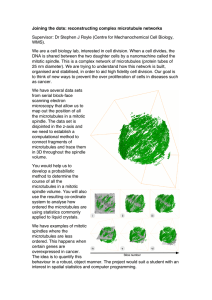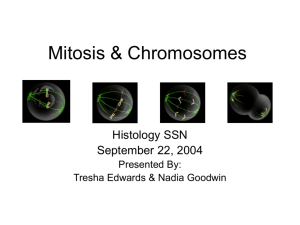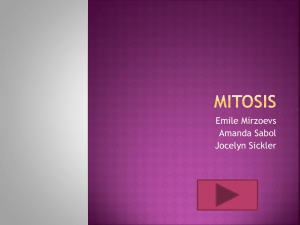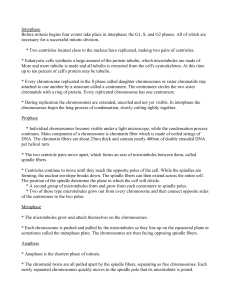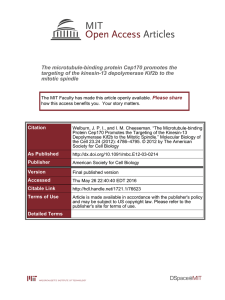1. The mitotic phase alternates with interphase in the cell cycle
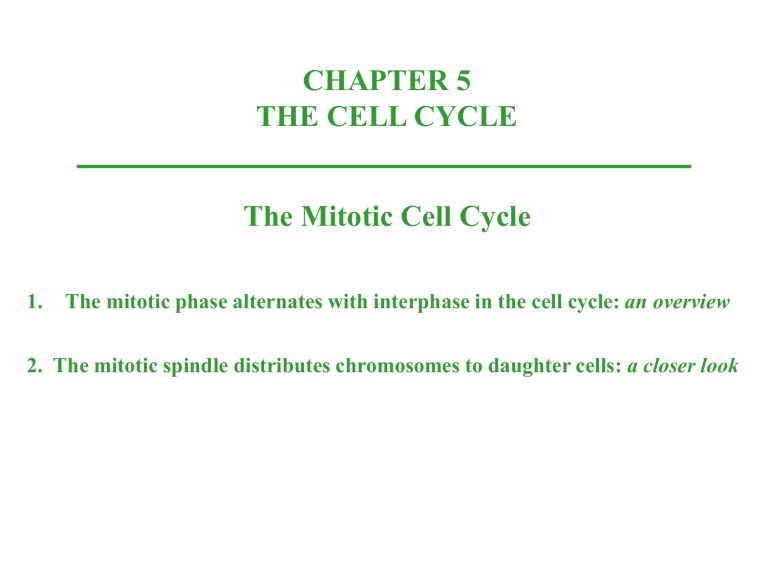
CHAPTER 5
THE CELL CYCLE
The Mitotic Cell Cycle
1. The mitotic phase alternates with interphase in the cell cycle: an overview
2. The mitotic spindle distributes chromosomes to daughter cells: a closer look
1. The mitotic phase alternates with interphase in the cell cycle: an overview
• The mitotic ( M ) phase of the cell cycle alternates with the much longer interphase .
• The M phase includes mitosis and cytokinesis.
• Interphase accounts for 90% of the cell cycle.
• During interphase the cell grows by producing proteins and cytoplasmic organelles, copies its chromosomes, and prepares for cell division.
• Interphase has three subphases:
• the G
1 phase (“first gap”) centered on growth,
• the S phase (“synthesis”) when the chromosomes are copied,
• the G
2 phase (“second gap”) where the cell completes preparations for cell division,
• and divides (M).
• The daughter cells may then repeat the cycle.
• Mitosis is a continuum of changes.
• For description, mitosis is usually broken into five subphases:
• prophase ,
• prometaphase ,
• metaphase ,
• anaphase , and
• telophase .
• By late interphase, the chromosomes have been duplicated but are loosely packed.
• The centrosomes have been duplicated and begin to organize microtubules into an aster (“star”).
• In prophase, the chromosomes are tightly coiled, with sister chromatids joined together.
• The nucleoli disappear.
• The mitotic spindle begins to form and appears to push the centrosomes away from each other toward opposite ends (poles) of the cell.
• During prometaphase, the nuclear envelope fragments and microtubules from the spindle interact with the chromosomes.
• Microtubules from one pole attach to one of two kinetochores , special regions of the centromere, while microtubules from the other pole attach to the other kinetochore.
• The spindle fibers push the sister chromatids until they are all arranged at the metaphase plate , an imaginary plane equidistant between the poles, defining metaphase.
• At anaphase, the centromeres divide, separating the sister chromatids.
• Each is now pulled toward the pole to which it is attached by spindle fibers.
• By the end, the two poles have equivalent collections of chromosomes.
• At telophase, the cell continues to elongate as free spindle fibers from each centrosome push off each other.
• Two nuclei begin for form, surrounded by the fragments of the parent’s nuclear envelope.
• Chromatin becomes less tightly coiled.
• Cytokinesis, division of the cytoplasm, begins.
2. The mitotic spindle distributes chromosomes to daughter cells: a closer look
• The mitotic spindle , fibers composed of microtubules and associated proteins, is a major driving force in mitosis.
• As the spindle assembles during prophase, the elements come from partial disassembly of the cytoskeleton.
• The spindle fibers elongate by incorporating more subunits of the protein tubulin.
• Assembly of the spindle microtubules starts in the centrosome.
• The centrosome ( microtubule-organizing center ) of animals has a pair of centrioles at the center, but the function of the centrioles is somewhat undefined.
• As mitosis starts, the two centrosomes are located near the nucleus.
• As the spindle fibers grow from them, the centrioles are pushed apart.
• By the end of prometaphase they develop as the spindle poles at opposite ends of the cell.
• Each sister chromatid has a kinetochore of proteins and chromosomal DNA at the centromere.
• The kinetochores of the joined sister chromatids face in opposite directions.
• During prometaphase, some spindle microtubules attach to the kinetochores.
• When a chromosome’s kinetochore is “captured” by microtubules, the chromosome moves toward the pole from which those microtubules come.
• When microtubules attach to the other pole, this movement stops and a tug-of-war ensues.
• Eventually, the chromosome settles midway between the two poles of the cell, the metaphase plate .
• Other microtubules from opposite poles interact as well, elongating the cell.
• One hypothesis for the movement of chromosomes in anaphase is that motor proteins at the kinetochore “walk” the attached chromosome along the microtubule toward the opposite pole.
• The excess microtubule sections depolymerize.
• Experiments support the hypothesis that spindle fibers shorten during anaphase from the end attached to the chromosome, not the centrosome.
• Non kinetichore microtubules are responsible for lengthening the cell along the axis defined by the poles.
• These microtubules interdigitate across the metaphase plate.
• During anaphase motor proteins push microtubules from opposite sides away from each other.
• At the same time, the addition of new tubulin monomers extends their length.
